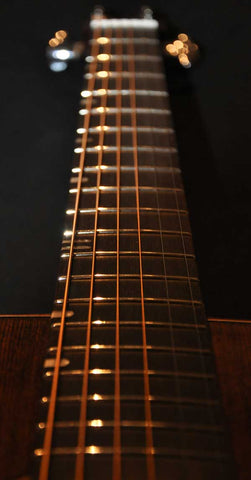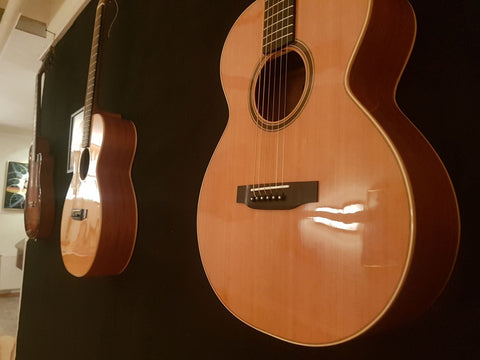
7 minutes read.
Buying a guitar can sometimes be overwhelming when you start comparing different models, features and materials without really knowing what to look for, and how your choices will affect the properties of your new guitar.
For the look - Well, we can’t help you with that - it’s just a matter of taste.
For the way it sounds, though, we can help you. We know that it’s impossible to try out every single guitar there is, and that it can be hard to make a good decision only based on your first impression in the shop.
We’ve put together some explanations of what the material choices in the different parts of your guitar will affect. It should give you the confidence you need to make a good decision for your new guitar!
Before we get into it, here are the woods you will hear about and the body parts :







The Top of the Guitar
One of the most important parts of a guitar is the top, because that’s where the vibrations of the strings come to life and start spreading through the body via the bridge bone.
Laminated wood won’t give you a lot of vibrations, and therefore you’ll get less feeling when you play. It’s advantage is that it will be more resistant to weather conditions like humidity and temperature, but it won’t sound as good, or give you any natural feedback as a solid wood top does.
For the greatest sound, you’ll want to go for a solid wood top, since it will resonate better. The guitar will “sing out” and give you feedback on what you want to express when you’re playing. There are easy ways to prevent solid wood guitars from cracks caused by weather conditions.
There are different types of woods that can be used for the tops. We recommend two:
- Spruce is a traditional tone wood for the top of the guitar that will sound better and better for every year. It will almost never fade out, and the sound will just get stronger the more the guitar is played. Sitka spruce from Canada is the most commonly used spruce in guitars.
-
Cedar can also be a good choice. It will give a little bit warmer sound with more bass. However, cedar has a tendency to fade out after 20 -30 years.
Cedar tops are more common in classical guitars and used more seldom in steel stringed acoustic. Many people like the look of it, as it looks like it has a bit of patina right from the beginning.
When the guitar is new, the top should be plane behind the bridge.
The Bridge
The bridge bone might be very small, but it is what leads the vibrations from the strings and into the body of the guitar, and is therefore very important. The rule of thumb is that the harder it is, the better it is, since it will let more vibrations come through to the top.
The best material for the bridge is bone - plastic is too weak and gives less response! Bone will also last the longest.
The Fretboard

For the fretboard, you will want wood like rosewood or ebony. Ebony is harder and will last a lifetime, but rosewood is a great choice too.
The Neck

The neck needs to be strong, so mahogany or maple are good options.
The neck should be at a straight angle to the body of the guitar, and be parallel to the top of the guitar. Otherwise you’re gonna get a buzzing sound when you play on certain frets. Also, watch out for a small bump at the 12th or 14th fret where the fretboard meets the body, since this also will lead to buzzing when you play high notes.
The Back and Sides

These are usually made of the same wood. The wood in the back and sides are what decides the character of the sound. The darker the wood the more bass you will get.
- Rosewood is dark and gives a rich bass and a wide range between bass and treble.
- Mahogany has a lighter color than rosewood and will give more treble and mid.
- Maple has a very light color and gives a lot of treble and a quick response.
None of these are better or worse than the others - It’s just a matter of how you want your guitar to sound and look.
The Finish
There are many different lacquer techniques for guitars, but it’s usually got either a high-gloss or satin finish. A satin finish is matte, and will give the guitar a vintage and natural look and can sometimes give a more open sound, but a high-gloss finish will be easier to keep clean. In the end, what finish you like is a matter of taste.


